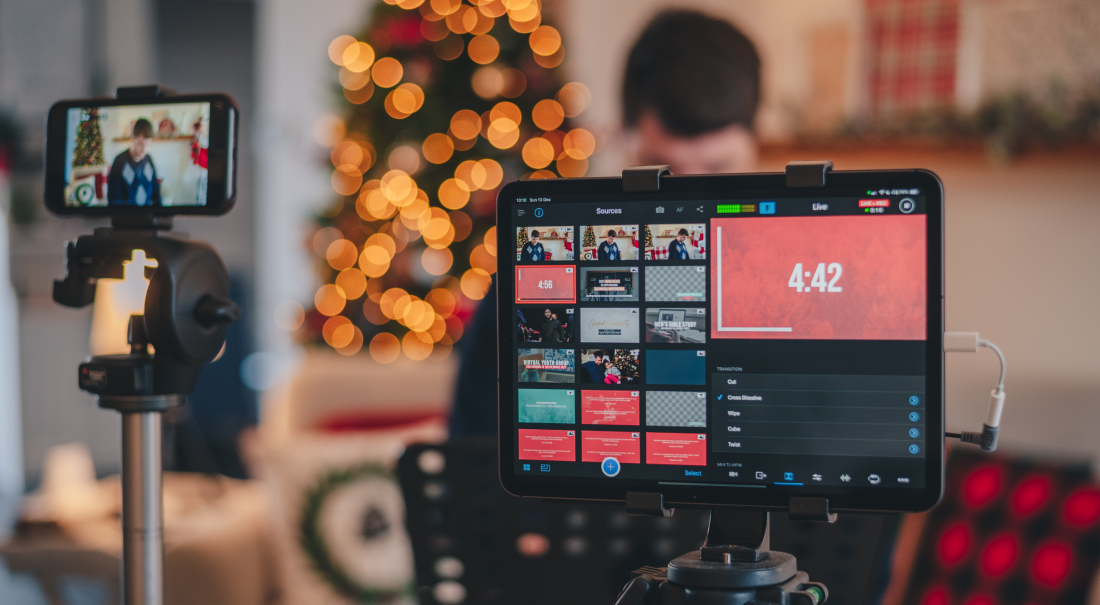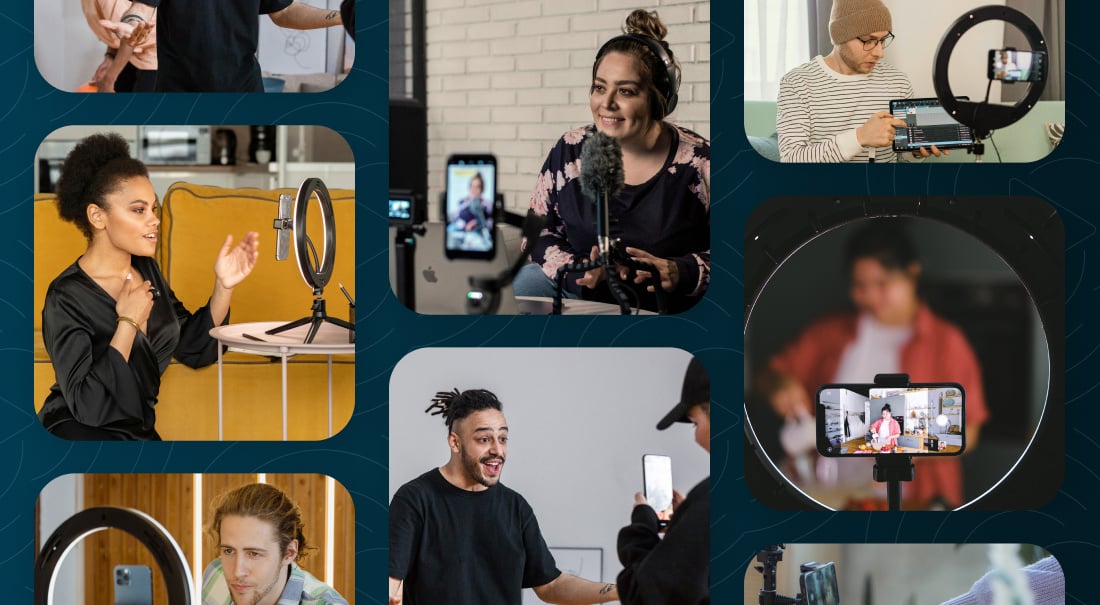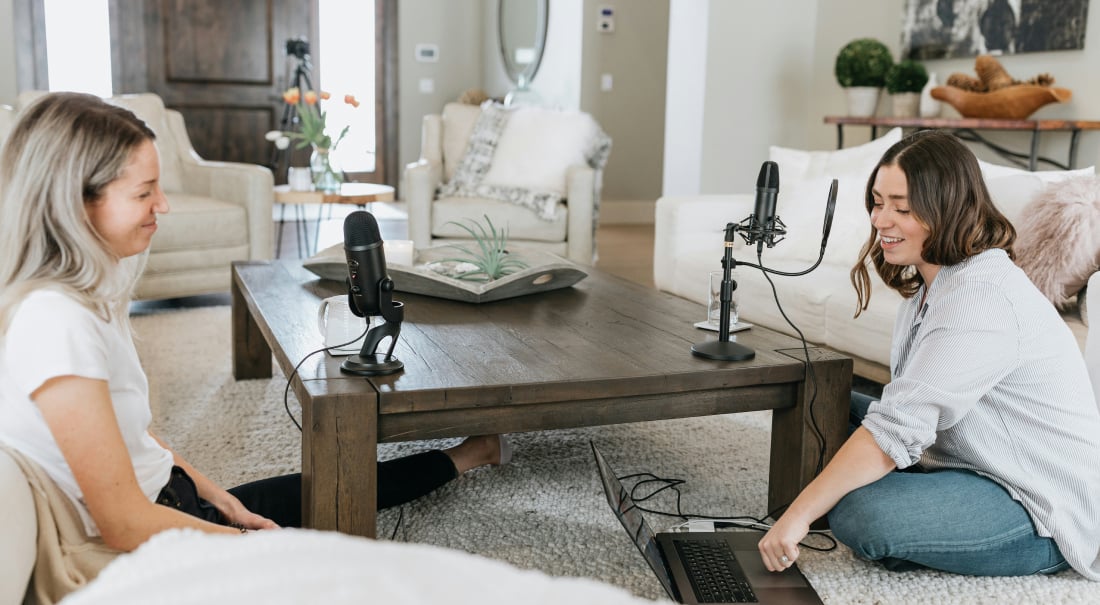
Influencers have been around for a while, but we’ve seen a huge uptick in influencer and affiliate marketing in the last few years. Influencer partnerships — especially with livestreams — can help boost sales and increase viewership, but many brands don’t know where to start.
I asked some questions of Switcher Studio’s Nick Walker, who manages our creator and influencer partnerships. As the resident pro in the field of influencer marketing, Nick’s insights will help any newbie find success! So if you’re wondering where to begin with influencer marketing or how to find influencers for your brand, consider this your "getting started guide."
Contents:
- What is "influencer marketing?"
- Affiliate vs. influencer marketing
- The difference between influencer tiers
- Why is influencer marketing effective … and when it's most effective
- How to find influencers for your brand
- What to look for in an influencer partnership
- How to reach out to potential influencer partners
- From initial outreach to agreement
- How to decide on your campaign, content, or timeline
- Helping influencer partnerships run smoothly
- What makes a successful influencer partnership
- What to know before getting started with influencer marketing
Influencer Marketing: The Basics
What is “influencer marketing?”
I like to think of influencer marketing as large-scale word-of-mouth marketing. Influencers are usually external content creators who have an audience, and that audience trusts the influencer's opinions and recommendations. This is key: influencer marketing can offer brands social proof (i.e., credibility).
The goal of influencer marketing is to engage with influencers who align with your brand, product, and messaging. The influencer creates content on your brand’s behalf and presents that content to their audiences. Hopefully, that content drives brand awareness and generates new customers.
What’s the difference between affiliate marketing and influencer marketing?
I think these terms get confused because there’s some overlap: Almost anyone (influencers included) can be an affiliate, but not all affiliates can be influencers. There are a couple of key differences between the two. The first is how they present a brand or product.
Influencer partnerships usually result in a curated social media content strategy. The content is effective because of the relationship between influencers and their audience, and the value of the partnership is usually based on the influencer’s own brand. By comparison, affiliates often do their marketing through advertising on a blog, website, or even apps.
Another key difference is the payment structure. Influencers are usually paid a flat rate for collaboration. Affiliates, on the other hand, are normally paid on commission, directly tied to the revenue they generate.
We hear a lot about different tiers of influencers, e.g., micro, macro, nano. What’s the difference between influencer tiers?
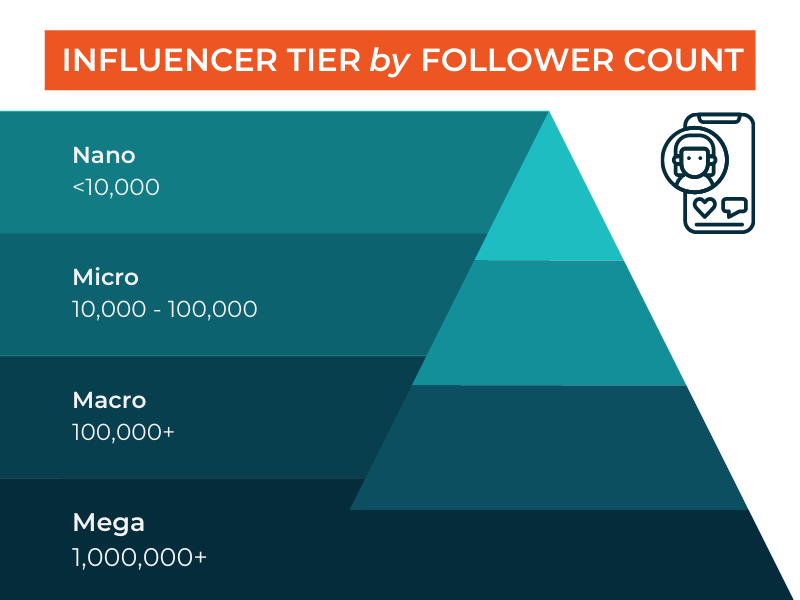
What’s interesting is that depending on who you talk to, everyone has different ideas about what defines these tiers. Generally, nano-influencers have fewer than 10,000 followers across all of their platforms, micro-influencers have about 10,000 - 100,000 followers, and macro-influencers have a reach or following of 100,000 or more. There’s also a “mega-influencer” tier with a reach of 1,000,000 or more!
The important thing to remember is that the size of an influencer’s audience is not directly proportional to the effectiveness of a campaign. Often the most potent influencer partnerships are with nano and micro-influencers because though their audiences are smaller, they’re highly engaged and enthusiastic.
Why is influencer marketing effective … and when is it most effective?
People tend to trust the opinions and advice of peers, friends, and people they admire (i.e., influencers) more than they trust brands. That’s why influencer marketing works: It goes back to the concept of social proof.
So when is influencer marketing most effective? When the endorsement is genuine and authentic. People are smart. They can tell the difference between a lip service brand endorsement and when influencers believe in a product. Authenticity is key.
To use Switcher as an example, a lot of our best, most effective influencer partnerships are with creators who would probably be using Switcher even if we weren’t sponsoring their content. They “get” Switcher, and their audience is interested in it too.
Getting Started: How to Find Influencers for Your Brand
Walk us through how to find influencers for your brand.
Before you even start looking for an influencer to partner with, you need to nail down some things:
- What are your values and mission?
- What’s your brand’s story?
- What’s the value of your product or service?
- Who are you trying to reach?
- What would a successful campaign look like?
Start with a crystal clear picture of your brand, your product, and your customer. This informs your search for influencers to partner with because you want someone who can tell your story the way it should be told and reach the people you want to reach. From there, decide what you want to accomplish with this partnership. Brand awareness? New customers? New social followers? Define what a “successful” campaign would look like for you.
Once you’ve established these key things, there are a few ways you can go about finding influencers to partner with.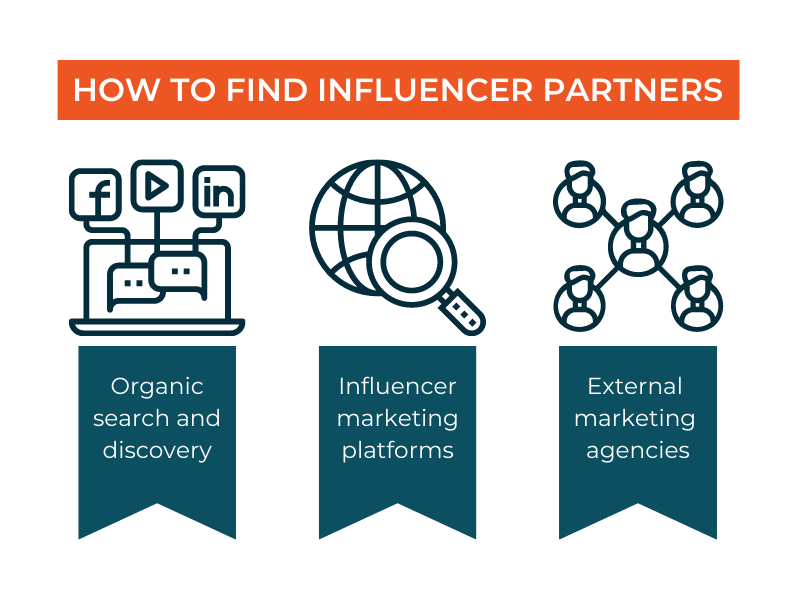
- Organic discovery. With this method, you search Google with keywords or comb through social platforms with hashtags. Your leads can be handpicked, which is nice, but it does take time.
- Influencer marketing platforms. For a price, you can filter by platforms, product categories, demographics, and so on. These platforms can help you discover potential partners fast, but it’s a bit less personal.
- Marketing agencies. These days many marketing agencies offer influencer discovery services, so you could also outsource this task. This would save you the most time but would be the most expensive and the least personal approach.
There are pros and cons to all of these methods of discovery. Your size and goals will inform which method is best for you.
What criteria should brands look for in an influencer partnership?
Keeping in mind what I said about authenticity, the first goal should be finding a creator who is a good fit for your brand (and vice versa.) When discovering potential influencers, I try to get a sense of their personality: Does it match up with our brand’s values and mission? Does their audience seem to match up to our customer profile?
Try not to be blinded by follower count. I look at the quality of content. No matter the size of an influencer’s audience, I hesitate to engage with them if they don’t put their best foot forward.
Of course, I also look at engagement. Low engagement is a red flag — it’s better to have a smaller audience with high engagement than the reverse, and often larger audiences with low engagement can indicate that followers were purchased.
How much do their followers engage with their content, and what kind of engagement is it? Are follower comments generic, or do they seem inspired by the content? You should be able to get a sense of how enthusiastic the audience is about the content they’re putting out.
The Nitty-Gritty of Influencer Partnerships
Once you pick out a prospect (or several), what’s next? How do you reach out to potential influencer partners?
Influencers are harder to get a hold of than they used to be. This is good for influencers because it means brands are recognizing their value and they can be choosier about partnerships. For brands, it means that you should definitely reach out to more people than you plan on working with.
I typically reach out with a personal email. I shoot for being transparent without being long-winded: I introduce myself, Switcher Studio, and I always mention what the influencer did or made that caught my attention. Then I explain that I’d like to have a conversation to see whether we’d be a good fit for the content they are creating.
I link to the website and keep the subject line straightforward so I don’t look like a spam email!
Walk us through the process from there. What takes you from that initial outreach to an agreement?
Ideally, the person you’ve reached out to responds that they’d also be open to a conversation! That usually happens through a video meeting or a phone call, and that’s when I offer them the chance to try out Switcher (if they haven’t already.) Like I mentioned before, I always want to work with influencers who are excited about our platform.
If both agree to move forward, you can start nailing down details like content ideas, timeline, and budget. My number one tip is talking out every detail so both parties are comfortable. This process generally takes about a month, depending on how responsive everyone is.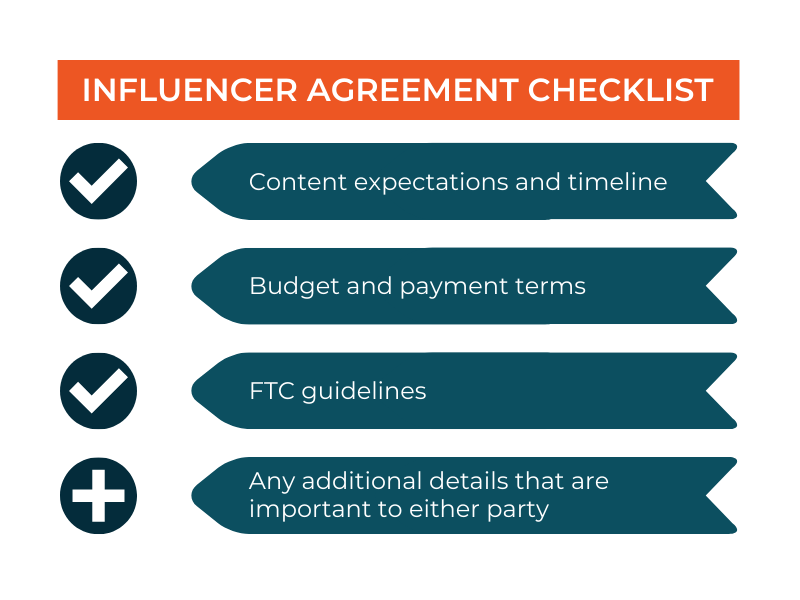
Of course, you want to get the agreement in written form, but by that time, the formal agreement should just reiterate what you’ve already discussed. An influencer agreement checklist would include things like dates, content expectations, payment terms, FTC guidelines, and any other details that are important to the brand or influencer. Once that agreement is in place, it’s really a matter of managing the campaign to make sure both parties are happy and things are moving along.
Once you have an influencer on board, what’s next? How do you decide on your campaign, content, or timeline?
When it comes to the schedule, give yourself (and the creator) plenty of time to bring this campaign together. Remember that sometimes the influencer you’re working with is also working with other brands, so your content is in a queue.
The campaign and content creation should be a collaborative process. It's easy for a brand to want to control exactly what's being said, but the influencer should have plenty of autonomy when creating this content. That’s a big part of making sure a collaboration runs smoothly: valuing what an influencer is bringing to the table creatively. It’s like commissioning a painting: You’re not telling the artist what brushstrokes to use, you just want to make sure they’re painting the right picture.
What are important things to remember while you’re working with an influencer partner? Is there anything you do that helps partnerships go more smoothly?
Be fair and respectful. Whenever possible, enter into an influencer partnership with long-term expectations and do what you can to help things go smoothly. That means paying on time, promptly reviewing content and giving feedback, and genuinely caring about who you are working with.
What Makes a Great Influencer Partnership
So how can you tell if an influencer partnership was successful or not?
A “successful influencer partnership” can mean different things. On a surface level, you can ask “were our goals met?” Were you trying to boost website traffic, get a good engagement rate, increase your social mentions, find new customers, or increase your social media followers? Map out your goals in advance and then compare.
Influencer marketing is about people, so I think it’s vital to go beyond the most impersonal measures of success. Ask “were both parties happy with the campaign?” If the brand and the influencer both feel good after a partnership, that’s a win. If both parties want to work together again, that’s even better. It may seem small, but this can be as important as the data and metrics because it indicates that the partnership has the potential to deepen and flourish over time. That kind of dynamic is unique to influencer marketing and can result in very fruitful collaborations.
We could talk about this topic all day, but what do you want to leave our readers with? What’s important to remember before getting started with influencer marketing?
Be patient. We all want immediate results, but (especially if you’re just getting started) it takes time to network, map goals, find the right influencer partners, and then get them acquainted with your product or service. That’s okay. In fact, I think that’s the right way to go about it.
I think just about any brand can benefit from some form of influencer marketing, but it’s not “plug and play.” Not every influencer (or style of campaign, for that matter) is a good fit for any brand. It can be useful to take inspiration from other brands using influencer marketing, but your brand is unique. The influencers you work with and the way those partnerships manifest should be unique to you.
The ultimate goal of influencer marketing is a lifelong partnership with an enthusiastic fan who also has influence. When everyone feels good about the collaboration and you get organic love and engagement on top of high-quality on-brand sponsored content — that’s influencer marketing at its best.
Thanks, Nick, for sharing your influencer marketing expertise! If you want more tips and insights from the Switcher team delivered straight to your inbox, make sure to sign up for our newsletter to get notified when we post.
Subscribe to the blog
Sign up to receive notifications whenever a new blog post is published. You may unsubscribe at any time.

Share
About the Author

Maddie is a writer and curious content marketer with experience in nonprofits, advertising, and tech. As Switcher’s content strategy manager, she’s passionate about connecting with our audience through content that educates and inspires.
All posts by Maddie Tong

